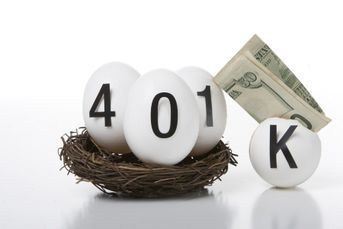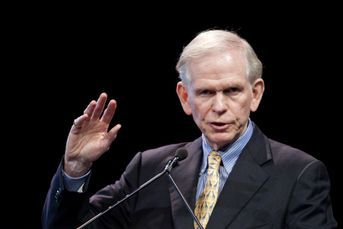Fear of rising rates hits high dividend-paying stocks
Investors' fear of rising interest rates is driving down shares of companies like Lockheed Martin, which makes the F-16 Fighting Falcon fighter jet, that pay high dividends. Some strategists suggest keeping at least a little exposure to these stocks as a bond substitute.
Shares of high-dividend-yielding companies are trading near the lowest level in almost three years relative to the market, as the prospect of higher interest rates makes these stocks less attractive to investors.
The Dow Jones U.S. Select Dividend Index has lagged behind the Standard & Poor’s 500 Total Return Index by 4.5 percentage points since April 30, 2013. During the same period, the yield on 10-year Treasuries has risen to 2.65% from 1.67%.
The dividend index — made up of 100 companies including Lockheed Martin Corp. and Philip Morris International Inc. — attracted investment amid the backdrop of low interest rates because it served as a “bond substitute,” by providing a higher yield, said Jack Ablin, who helps manage $66 billion in assets as chief investment officer at BMO Private Bank in Chicago. This favorable investment backdrop is reversing, he said.
“If the U.S. economy stays on the path it’s on, 10-year Treasury rates could hit 4% this year, pushing these stocks further out of favor,” Mr. Ablin said.
Even though the harsh winter could slow U.S. growth during the first quarter, it won’t harm the economy enough to prompt “a fundamental change in the outlook” for the Fed’s reduction in bond purchases that were aimed at lowering interest rates, William C. Dudley, president of the New York Fed, said March 6 at an event in New York. “The threshold is pretty high to change it.”
YIELDS RISING
The yield on 10-year Treasuries will increase to 3.35% by the end of 2014, according to the median forecast of economists surveyed by Bloomberg. That forecast is down slightly from February’s survey of 3.4%. Meanwhile, gross domestic product will expand 1.9% in the first quarter and accelerate to 3% by year-end, according to the median forecast of economists.
Interest rates started to rise in May when the Federal Reserve began bracing investors for a phase-out of its unprecedented monetary stimulus.
That increase was temporarily interrupted in January by concern about a global slowdown caused by emerging market economies, said William O’Donnell, head U.S. government-bond strategist at Royal Bank of Scotland Group’s RBS Securities unit. In the past month, rates have drifted “moderately higher” again, driven in part by the prospect of a modestly better U.S. economic backdrop, along with improving corporate and household balance sheets, he said.
Shares of companies that pay high dividends track closely with 10-year Treasuries, so amid a correction in the markets in January, there was some “flight to safety” that favored these types of stocks, according to Jeff Mortimer, director of investment strategy in Boston for BNY Mellon Wealth Management. While such volatility could continue throughout the year, longer-term — the next 12 to 18 months — “stocks that have a bond-like component will be weighed down by rising interest rates,” he said.
In the past year, this group has been trading in a “series of declining peaks” relative to the market as investors allocate a smaller amount of money to them than to other companies in the S&P 500, said Jim Stellakis, founder and director of research at research company Technical Alpha Inc. “These lower highs show investors want progressively less and less exposure to high-dividend paying companies.”
DETERIORATING APPETITE
Relative to the benchmark, the dividend index is trading near a “big support level” and if it were to trade below a March 2012 threshold in a “decisive manner,” this would signal the appetite for these stocks has deteriorated a lot more, Mr. Stellakis said. “These stocks are hanging on right now.”
The dividend group also includes General Mills Inc. and Clorox Co.
Not every analyst believes 10-year Treasury rates will rise. They could fall to 2.25% this year because there’s no sign of inflation on the horizon, according to Andrew Wilkinson, chief market analyst at Interactive Brokers. “To agree with the consensus forecast, you have to be convinced the economic recovery will be sufficiently strong to withstand a rise in interest rates that won’t impact demand, particularly in housing.”
Gross domestic product expanded at a slower-than-projected 2.4% pace in the fourth quarter, down from a prior estimate of 3.2%, Commerce Department data show.
Still, the rotation out of this group already is underway, Mr. Mortimer said. He recommends investors don’t forsake all of these companies and instead pair select “high-dividend payers” with high-growth stocks in industries such as technology, health care and biotechnology that don’t have as high a payout, he said.
As rates climb higher this year — Mr. O’Donnell forecasts the yield on 10-years will increase to a “more benign” 3.2% — “Treasuries will become a better alternative to riskier assets like high-dividend-paying stocks,” he said. A larger portfolio adjustment probably won’t be triggered until interest rates breach at least this level, he said.
“We’re in a transition period to higher rates, illustrated by the weakness in high-dividend-paying stocks,” Mr. Mortimer said.
Bloomberg News
Learn more about reprints and licensing for this article.








